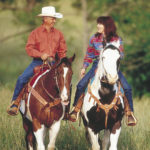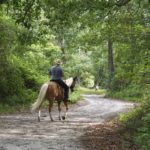American kids need more activity to fight rising levels of obesity. Horses provide a terrific solution–now and throughout your child’s life.
Is your child a couch potato? If so, she isn’t alone. Health experts have been sounding the alarm about too little physical activity and too much obesity among our young people for some time.
A report published in The New England Journal of Medicine says this trend could mean that life expectancies in the U.S. will soon begin to fall–for the first time in two centuries. In other words, left unchecked, the rapid rise in childhood obesity will mean the current generation of American youngsters may have a shorter average lifespan than their parents did. This is because obesity is associated with a range of illnesses, including Type 2 diabetes, heart disease, kidney failure, and cancer.
In this article, we’ll look at some of the reasons your child and other youngsters in our country may be less active than they should be, a key contributor to obesity. We’ll also suggest a great way to get kids moving, using something your child will love: horses.
We’ll show how equestrian activities can help get your children off the couch, out of the house, and into something that can help keep them fit and happy over a lifetime.
HOW BAD IS IT?
In her new book Fed Up! Winning the War Against Childhood Obesity (Joseph Henry Press, 2005), author Susan Okie, M.D., calls the unprecedented increase in the number of overweight children “a true public health emergency.” In a chapter titled “The Fattest Generation,” she reports that since the 1970s, the prevalence of obesity in the U.S. has more than tripled among children aged 6 to 11, and more than doubled among younger children (2 to 5) and adolescents (12 to 19).
She also points to a recent study conducted by Brigham Young University of kids aged 6 to 12 in the U.S., Sweden, and Australia. Researchers found that the U.S. children were the least active and heaviest of all.
Why is this? Credit the influence of television, video games, and the Internet, all of which children find attractive and, in some cases, almost addictive. Plus, pervasive marketing aimed at children in the U.S. reinforces all these behaviors, as well as the gobbling of junk foods that contribute to obesity.
Of all the causes of a sedentary lifestyle, television watching is clearly the worst. As reported by Okie, American children between the ages of 2 and 17 spend an average of three years of their waking lives watching TV. For this reason, not even the best school PE programs can solve the problem of childhood obesity on their own.
According to James Sallis, a researcher quoted in Okie’s book, after-school activities are critical. If kids aren’t active after school, says Sallis, “then they’re not active”?period.
Okie adds that getting kids hooked on something active is easier when the pastime in question is appealing. As she points out, “kids do things because they want to, not because someone has told them it’s healthy.”
Okie doesn’t mention equestrian activities specifically, but she does praise individual sports (which would include horseback riding) as at least as important as team sports. This is because children may be more likely to continue to enjoy them as adults, thereby setting a pattern for lifelong fitness.
The need to find an enticing, long-lasting activity is especially critical for girls. Okie notes that there are biological factors that cause a remarkable drop in the physical activity of girls at puberty. This means we need creative ways of encouraging girls, especially, to stay physically active throughout adolescence.
And to that we can only say: Horses, anyone?
A HAPPY SOLUTION
Horse involvement provides the perfect antidote to couch-potato-itis. Riding requires regular practice, for both the horse’s and the rider’s benefit. And, in families that own horses, caring for the animals is an every-day requirement. Unlike a bicycle, a horse can’t be left standing in the garage until a child feels like riding it.
Plus, the activities associated with riding and caring for a horse can provide a full range of health benefits, including:
Muscle toning. Riding develops strong, well-toned muscles in the lower body. Sports medicine specialist Richard Leavitt, Ph.D., often prescribes exercise programs that include horseback riding for his patients. He believes riding is especially good for girls and women because it works the thigh and buttock muscles they often find problematic. “A person only has to ride a horse one time to feel which muscles are being used,” observes Dr. Leavitt.
Horse care, meanwhile, targets the upper body. Grooming, hoof-picking, toting buckets, cleaning stalls?all of these provide great toning and strengthening for the muscles of the arms, chest, and back.
Stretching. Certain equestrian activities, such as mounting, provide a great muscle stretch in and of themselves. But beyond that, dedicated riders are motivated to improve their suppleness and flexibility to increase their dexterity in the saddle. There are even yoga and pilates routines that have been designed specifically with riders in mind.
Balance boosting. A secure seat requires excellent balance, an attribute that becomes highly developed in regular riders. Riding also enhances a person’s sense of rhythm and timing, as being able to follow the movement of the horse at various gaits is essential to graceful equitation.
Calorie-burning. On their own two feet or from the back of a horse, equestrians cover a lot of ground on any given day. Plus, horse activities burn more calories than you might think
The health benefits of horses go beyond the workout values, however. Riding gets a child out of the house (or gym) and into the fresh air and sunshine. The benefits of horses as stress-relievers are widely known. Plus, the bond of trust a child develops with a good horse and the skills she gains are great confidence-boosters, especially during the adolescent years.
Moreover, horseback riding is increasingly available as a team sport in high school and college, so youngsters don’t have to leave it behind as they grow up.?And, in adulthood, they may well find horse involvement the perfect way to encourage mental and physical fitness?and avoid couch-potato-itis–in their own families.
“EQUI-CISE” THE CALORIES AWAY!
In its fact sheet on what it calls “Equi-cise,” the American Quarter Horse Association offers these comparisons:
- Vigorously grooming a horse can burn roughly as many calories as playing doubles tennis.
- Riding at a walk is about equivalent to playing catch or walking at 2 mph.
- Riding at a posting trot is similar to race walking, biking at 12 mph, or playing a friendly game of hoops.
Here are some additional calorie-burning estimates for other activities:
- Cleaning a stall for 20 minutes burns up to 185 calories.
- Sweeping a barn aisle for 20 minutes burns up to 110 calories.
- Loading/unloading feed for 30 minutes burns up to 180 calories.
- Riding at the canter for 10 minutes burns up to 110 calories.
(Note: To obtain a copy of AQHA’s fact sheet on Equi-cise, call 1-877-4aHORSE or go to www.4aHORSE.com.)
This article originally appeared in Growing Up With Horses, published by Equine Network.





